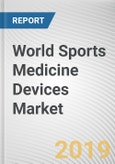On the other hand, the lack of trained professionals for sports medicine and the exorbitant price of certain devices and products serve to hinder market growth. Nevertheless, a general apprehension of the benefits of sports medicine devices- made possible through training programs and market penetration, and expansion in emerging countries of the Asia-Pacific region present key opportunities for the growth of this market. Technological advancements and the discovery of novel technologies are principle strategies followed by major players in this market. The key companies profiled in this report are Arthrocare Corporation, Biomet, Inc., Arthrex, Inc., Cayenne Medical Inc, Breg Inc., Zimmer Inc., Wright Medical Group Inc., Smith & Nephew Inc., Mueller Sports Medicine, Inc., and FH Orthopedics Inc. amongst others.
The global sports medicine market is segmented into product type, application area and geography. On the basis of product type the market is segmented into orthopedic and support and recovery products. Orthopedic products include arthroscopy devices, fracture repair devices, artificial joint implants, orthobiologics and prosthesis. Support and recovery products include surgical equipment, compression clothing, support devices, tapes, bandages and others. Arthroscopy devices dominate the market due to their joint-related issues. Fracture repair devices and artificial joint implants are also gaining ground due to the rising incidence of fractures and growing demand for joint replacements. On the basis of application, the market is segmented into Hand-wrist, Shoulders, Ankle-foot, Arm-elbow, Knee, Back-spine and Hip-groin. Shoulder and Knee treatment generated the highest revenue as most sports injuries are knee-related. Furthermore, the increasing number of age-related complications caused by diseases such as rheumatoid arthritis is also fueling market growth.
In terms of geography, the market is segmented into various regions, namely, North America, Europe, Asia Pacific and LAMEA. North America holds the largest market share and will retain its position throughout the estimated period due to the widespread acceptance of various sports which inevitably result in injuries and the increasing number of specialized sports services. Europe held the second largest market share due to the growing demand for the prevention and treatment of sports related injuries. That said, the Asia-Pacific region is the fastest growing region in this market due to the rise in the number of sport injuries, growing fitness awareness among the elderly as well as the youth, favorable government regulations for sports devices and improving healthcare infrastructure.
KEY BENEFITS
Extensive analyses of the factors that drive and limit the growth of the global sports medicine market are provided.
Deep dive analysis of segments such as product type and applications provide insights that would enable companies to gain competitive edge.
In-depth analysis of various regions would enable an understanding of the trends in various regions so that companies can
Methodology
The analyst offers exhaustive research and analysis based on a wide variety of factual inputs, which largely include interviews with industry participants, reliable statistics, and regional intelligence. The in-house industry experts play an instrumental role in designing analytic tools and models, tailored to the requirements of a particular industry segment. The primary research efforts include reaching out participants through mail, tele-conversations, referrals, professional networks, and face-to-face interactions.
They are also in professional corporate relations with various companies that allow them greater flexibility for reaching out to industry participants and commentators for interviews and discussions.
They also refer to a broad array of industry sources for their secondary research, which typically include; however, not limited to:
- Company SEC filings, annual reports, company websites, broker & financial reports, and investor presentations for competitive scenario and shape of the industry
- Scientific and technical writings for product information and related preemptions
- Regional government and statistical databases for macro analysis
- Authentic news articles and other related releases for market evaluation
- Internal and external proprietary databases, key market indicators, and relevant press releases for market estimates and forecast
Furthermore, the accuracy of the data will be analyzed and validated by conducting additional primaries with various industry experts and KOLs. They also provide robust post-sales support to clients.

LOADING...








